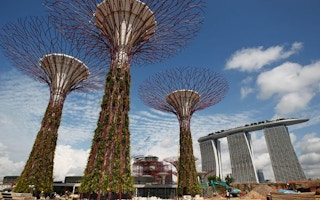Global studies in green building trends have revealed a greater awareness and willingness by both the public and private sectors worldwide to embrace sustainable ways of building and to pursue energy efficiency in buildings.
One study by McGraw Hill Construction late last year showed that green building is growing around the world. More than half the 800 organisations surveyed across 65 countries were planning for more than 60 per cent of their work to be green by 2015 - this is a jump from the 28 per cent in 2012 and 13 per cent in 2009.
In another separate survey of more than 3,000 decision-making industry professionals in 10 countries by energy services firm Johnson Controls released in June, global interest in energy efficiency rose 116 per cent since 2010.
Experts at the three-day International Green Building Conference in Singapore presented these findings to delegates on Wednesday at Marina Bay Sands.
Speaking at a discussion on global and regional green building trends, McGraw Hill vice president Harvey Bernstein noted that this growth of green buildings around the world is not confined to just one country or region - it triples in South Africa, doubles in Germany, Norway and Brazil, and grows between 33 and 68 per cent in the United States, Singapore, the United Kingdom, the United Arab Emirates and Australia.
“This increasing focus on sustainability from building owners will be a significant driver of market growth,” he said.
While in the past, the top driver for green building was “doing the right thing”, as a 2008 study found, in 2012, business drivers such as client and market demand are the key factors influencing the market, he said.
In other words, the greening of buildings has become a business imperative.
“
The top trigger for green building activity in Singapore was government regulation, and for nine other Asian countries, it was branding and public relations.
McGraw Hill study
The study also revealed that while the level of engagement in green buildings in Asia is comparable to the global average, Singapore has a much higher level of activity, with 64 per cent of those surveyed greening at least half their projects in 2012, with an even higher percentage expected by 2015.
The top trigger for its high activity was the active role the government took in creating green building policies and incentives.
Other Asian countries said branding and public relations is a top reason as such buildings offer a marketing advantage over their competitors.
The study also revealed ranked the obstacles standing in the way of greater adoption. Top of the list was higher upfront costs, followed by lack of public awareness and lack of political support or incentives.
Rob Moult, Johnson Controls vice president of marketing and solutions for Asia, said that similar reasons surfaced in the firm’s 2013 Energy Efficiency Indicator survey, which cited lack of funding as the top reason why building owners are reluctant to pursue higher energy efficiency performance for their buildings.
This was followed by insufficient return of investment and the uncertainty over savings and performance.
Zachary Tofias, director of the C40 Sustainable Communities Initiative, said that the key to addressing these challenges lie in the hands of the public sector as they can lead the way and set the regulations for the private sector to follow.
“Mayors and city governments have the power and willingness to act on climate change,” he said, adding that cities face the greatest risks from its effects as 90 per cent of the world’s cities are in coastal regions.
Mayors and city authorities have direct control over city streets and parking, transport, waste, building codes, water supply and urban planning, he noted.
C40 supports these cities with networks where cities can share best practices, and through specific projects where , for example, they help vulnerable cities come up with climate adaptation plans to address the potential negative effects of climate change.
Moderator of the discussion, Ashok Lall, principal architect at Indian firm Ashok B Lall Architects, said that from the recent findings, there is no doubt that “energy and carbon emissions are commanding the world’s attention.”
“Certainly in the next generation, we will see an even greater surge in this movement,” he said.
Eco-Business.com’s special event coverage of the International Green Building Conference 2013 is brought to you by City Developments Limited (CDL).













